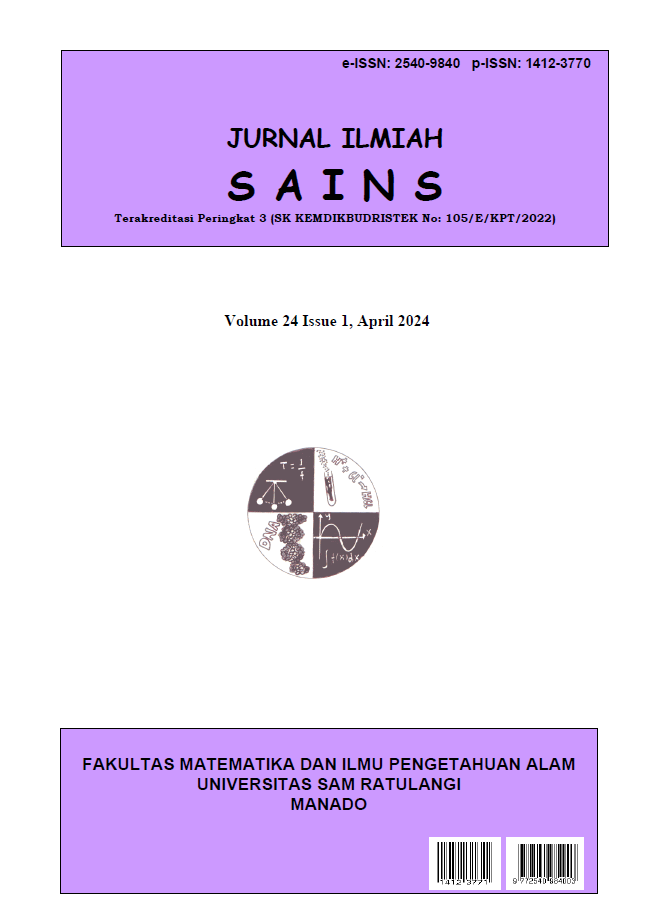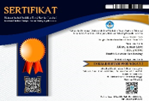Assimilate Partition of Potato (Solanum tuberosum L.) as Response to Combination of Paclobutrazol and Nitrogen
DOI:
https://doi.org/10.35799/jis.v24i1.52823Keywords:
Potato (Solanum tuberosum L), nitrogen, paclobutrazol, partition assimilateAbstract
Increasing the productivity of potato (Solanum tuberosum L.) can be done by increasing biological production (biomass) and the ability to convert (partition) assimilate/photosynthate into economic results (tubers). The aim of this research is to find a better combination of paclobutrazol (PBZ) application and nitrogen (N) fertilization for tuber partition assimilate of potato. The experiment was conducted in Randomized Block Design (RBD) with three replications. The treatment was consists of nine combinations of PBZ treatments and N fertilization as follows: 1) 3 kg PBZ/ha + 200 kg N/ha, 2) 3 kg PBZ/ha + 250 kg N/ha, 3) 3 kg PBZ/ha + 300 kg N/ha, 4) 3,5 kg PBZ/ ha + 200 kg N/ha, 5) 3,5 kg PBZ/ha + 250 kg N/ha, 6) 3,5 kg PBZ/ha + 300 kg N/ha, 7) 4 kg PBZ/ha + 200 kg N/ha, 8) 4 kg PBZ/ha + 250 kg N/ha, 9) 4 kg PBZ/ha + 300 kg N/ha. The research results showed that at the beginning of growth up to 42 DAP (day after plan), the assimilate (dry material) was directed towards stem and leaf (shoot) growth. Next, at 56 DAP to 84 DAP the assimilate is allocated for tuber growth. The combination of 4 kg PBZ/ha + 200 kg N/ha produces the largest tuber weight
Keywords: Potato (Solanum tuberosum L); nitrogen; paclobutrazol; partition assimilate
References
Arifin, M.S., Nugroho, A., Suryanto, A. 2014. Kajian panjang tunas dan bobot umbi bibit terhadap produksi tanaman kentang (Solanum tuberosum L.) varietas Granola) [Disertasi]. Brawijaya Univrsity, Malang, Indonesia.
Azima, N.S., Sumadi, A.N. & Hamdani, J.S. (2017). Respon Pertumbuhan dan Hasil Benih Kentang G0 di Dataran Medium terhadap Waktu dan Cara Aplikasi Paklobutrazol. J. kultivasi, 16(2), 313-319.
De Araújo, F.F., Santos, M.N.D.S., De Araújo, N.O., Da Silva, T.P., Costa, L.C. & Finger, F.L. (2020). Growth and dry matter partitioning in potatoes as influenced by paclobutrazol applied to seed tubers. Revista Colombiana de Ciencias Horticolas, 14(1), 135–143. https://doi.org/10.17584/rcch.2020v14i1.10357.
Duguma, H., Aga, M.C., Duguma Muleta, H., & Chewaka Aga, M. (2019). Muleta dan aga 2019. Mosisa Chewaka Aga. Role of Nitrogen on Potato Production: A Review. Journal of Plant Sciences, 7(2), 36–42. https://doi.org/10.11648/j.jps.20190702.11.
Godebo, D.K., Desta, B., Shenderu, A. & Belay, T. (2020). Effect of Nitrogen Fertilizer (Urea) Rate Application on Growth Performance of Potato (Solanum Tuberosum L.) on Vertisols of Central Highland of North Shewa, Ethiopia. Advances in Life Science and Technology, 80, 1-5. https://doi.org/10.7176/alst/80-01.
Güler, S. (2009). Effects of Nitrogen on Yield and Chlorophyll of Potato (Solanum tuberosum L.) Cultivars. Bangladesh J. Bot., 38(2), 163-169.
Howlader, O., & Hoque, M. (2018). Growth Analysis and Yield Performance of Four Potato (Solanum tuberosum L.) Varieties. Bangladesh Journal of Agricultural Research, 43(2), 267–280. https://doi.org/10.3329/bjar.v43i2.37330.
Ruža, A., Skrabule, I., & Vaivode, A. (2013). Influence of Nitrogen on Potato Productivity and Nutrient Use Efficiency. Proceedings of the Latvian Academy of Sciences, Section B: Natural, Exact, and Applied Sciences, 67(3), 247–253. https://doi.org/10.2478/prolas-2013-0043.
Sambeka, F., Runtunuwu, S.D., & Rogi, J.F.X. (2012). Efektifitas waktu pemberian dan konsentrasi paclobutrazol terhadap pertumbuhan dan hasil kentang (Solanum tuberosum L.) Varietas supejohn. Eugenia, 18(2), 126-134.
Sriom, Mishra, D.P., Rajbhar, P., Singh, D., Singh, R.K., & Mishra, S.K. (2017). Effect of Different Levels of Nitrogen on Growth and Yield in Potato (Solanum tuberosum L.). International Journal of Current Microbiology and Applied Sciences, 6(6), 1456–1460. https://doi.org/10.20546/ijcmas.2017.606.170.
Syabudin. Y., Yuwariah, J.S., Hamdani, & Sumadi. (2013). Peningkatan Kualitas Hasil Ubi Tiga Varietas Kentang Melalui Aplikasi Paklobutrazol di Dua Dataran Medium. IJAS, 3(1), 13-19.
Tekalign, T., & Hammes, P.S. (2004). Response of potato grown under non-inductive condition to paclobutrazol: shoot growth, chlorophyll content, net photosynthesis, assimilate partitioning, tuber yield, quality, and dormancy. Plant Growth Regulation, 43(3), 227-236. DOI:10.1023/B:GROW.0000045992.98746.8d.
Tekalign, T., & Hammes, P.S. (2005). Growth responses of potato (Solanum tuberosum) grown in a hot tropical lowland to applied paclobutrazol: 2. Tuber attributes. New Zealand Journal of Crop and Horticultural Science, 33(1), 43-51. https://doi.org/ 10.1080/01140671.2005.9514329.
Villa, P.M., Sarmiento, L., Rada, F.J., Machado, D., & Rodrigues, A.C. (2017). Leaf Area Index of Potato (Solanum tuberosum L.) Crop Under Three Nitrogen Treatments. Agronomia Colombiana, 35(2), 171–175. DOI: 10.15446/agron.colomb. v35n2.62110.
Villa, P.M., Sarmiento, L., Rada, F.J., Rodrigues, A.C., Márquez, N., & Espinosa, W. (2020). Partition of biomass and nitrogen in a potato crop under three nitrogen fertilization treatments. Siembra, 7(2), 57-68. DOI: 10.29166/siembra.v7i2.2235.
Workineh, G., Loha, G., & Hidoto, L. (2017). Response of Potato (Solanum tuberosum L.) to Nitrogen Fertilizer Application at Angecha, Southern Ethiopia. Journal of Natural Sciences, 7(3), 5-14.
Downloads
Published
How to Cite
Issue
Section
License
Copyright (c) 2024 Semuel Runtunuwu, Edy F. Lengkong, Stella Tulung, Deisire N.S. Darus

This work is licensed under a Creative Commons Attribution-NonCommercial 4.0 International License.
LICENCE: CC-BY-NC
This work is licensed under a Creative Commons Attribution-NonCommercial 4.0 International License







